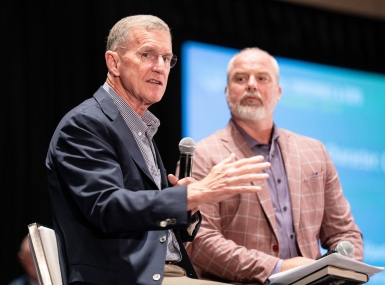Turning Gray: Ensuring that Your County Is a Good Place to Grow Up … and Grow Old In
Author

Sandy Markwood
Upcoming Events
Related News

We knew it was coming, but somehow it still crept up on us before we were ready: America is graying. Scientific advances allow people to live longer than ever before and, as a result of the post-World War II baby boom, there are more people who are growing older than ever before. These trends will continue for the next several decades. The graying of the population will have a direct and dramatic impact on county policies, programs and services nationwide.
Ninety-seven percent of U.S. counties realized an increase in their 65-plus population since 2010. Based on the Census numbers, the Pew Research Center estimates that between 2010 and 2014, on average, a U.S. county’s aging population rose by 12.4 percent.
While many of the counties with the fastest aging population are in Florida, other counties across the country are aging quickly. For example, Douglas and Elbert counties in Colorado, and Routt County, Wyo. had increases in the aging population greater than 50 percent in that timeframe. The grayest counties in the U.S.— all with a percentage population of 65-plus greater than 33 percent—include counties from Virginia, Arizona, New Mexico, Michigan and Texas. These are not counties that older adults are moving to, but rather counties where people are aging in place.
Ninety percent of older adults prefer to age in their existing home or community, according to AARP studies. Many people will need support from friends, family and the community to remain living independently, due to chronic conditions or the onset of Alzheimer’s disease or other dementias. The top three services that older adults request to allow them to continue living at home and in the community are transportation services, home and community-based aging services (meals, personal care, caregiver support) and housing supports, including home modification and repair.
As the population of older adults grows, counties realize the need to support people of all ages as they grow up and grow old with maximum independence, safety and well-being. County policies, programs and services related to housing, transportation and land-use regulations, as well as the community attitude, support and engagement of people across their lifespan, affect whether older adults can live successfully and productively at home and in their community.
Many county governments are responding to the graying of their population and putting strategies into place to capitalize on the assets of their rapidly increasing aging population and responding to the challenges that people face as they age.
For example, through the Partnership for Age Friendly Communities, Larimer County, Colo. is working to increase mobility access for its growing aging population. The “Try Transit” campaign is focused on generating awareness of and comfort in using the local transportation systems. Additionally, Larimer County is developing creative housing options to enable older adults who want to move from their existing house to find other appropriate housing options in the community.
Prince George’s County, Md., along with its neighbor Montgomery County, became one of the first national pilots for Dementia Friendly America (DFA), a national effort to assist communities to support citizens living with dementia as well as their care partners.
The DFA initiative provides a community toolkit and resources to engage all sectors of a community including law enforcement, first responders, businesses, housing, banking, transportation and health care to take steps to develop informed, safe and respectful strategies to support people with dementia.
To successfully enhance the ability of law enforcement officers to investigate and prosecute elder abuse and dependent adult abuse, the San Bernardino County, Calif., Department of Aging and Adult Services created the PC 368.1 Law Enforcement Information Card and training program. The effort provides officers with penal codes applicable to elder and dependent adult abuse that assist them in filing proper charges against perpetrators while also outlining what Adult Protective Services can do to support the treatment of victims.
Preparing your county to meet the needs of today and tomorrow’s older Americans is not necessarily an effort that demands an infusion on new funding but rather requires your county to intentionally look at the policies, programs and services that are in place and determining if they are or how they could be made more age-friendly. Planning to make your county more age-friendly will result in making your county a life-long community—a good place to grow up and to grow old.
Attachments
Related News

J.D. Clark is up to a Texas-sized challenge
NACo's new president got his start in county government covering meetings for his local newpaper as a high school student.

NFL veteran harnesses magic and forgiveness to overcome adversity
No matter what the world throws at you, it’s up to you to chart your own path, NFL veteran and magician Jon Dorenbos told the NACo Annual Conference attendees.

Leading with purpose: Lessons from a four-star general
What do a county leader and a four-star general have in common? More than you might think.